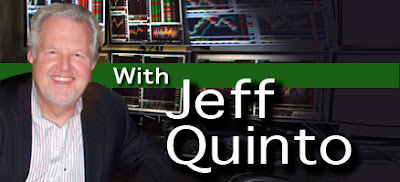Wednesday, October 28, 2009
 Today Trading RM was visited by Jeff Quinto. Jeff is a 37 year veteran of the markets. His experience includes the Kansas City Board of Trade, Chicago Board of Trade, running an electronic futures trading prop firm, and serving as a personal trading coach to many traders. In addition to coaching traders, Jeff also teaches a course at Northwestern University school of continuing education: Introduction to Electronic Trading, does a monthly video at Option News Network, and has frequent podcasts available on itunes. Jeff also has some great videos available on his website or on the website of the CME Group. I highly recommend these videos. Please visit Jeff's website for more detailed information.
Today Trading RM was visited by Jeff Quinto. Jeff is a 37 year veteran of the markets. His experience includes the Kansas City Board of Trade, Chicago Board of Trade, running an electronic futures trading prop firm, and serving as a personal trading coach to many traders. In addition to coaching traders, Jeff also teaches a course at Northwestern University school of continuing education: Introduction to Electronic Trading, does a monthly video at Option News Network, and has frequent podcasts available on itunes. Jeff also has some great videos available on his website or on the website of the CME Group. I highly recommend these videos. Please visit Jeff's website for more detailed information.
Jeff broke his talk to us into two parts.
Breaking up the day
Jeff talked to us about breaking up the trading day. He divides the trading day into 5 "quintos." Jeff likes to use open, morning, lunch, afternoon, and close. The exact number of parts to the day or their exact specific time is not important. What is important is recognizing that there are different areas of the day where the market behaves differently. This is because the various market participants behave differently. What does a fund manager do at lunch? What does he do at the open? What are day traders doing at the close? What are market makers doing in the afternoon? Accordingly, we, as day traders, must adjust our trading during these parts of the day.
Despite the world being a 24 hour trading environment, the market seems to revolve around U.S. equity hours. What happens is we see a flood of liquidity during the open period. The morning is characterized by liquidity and fluidity. During lunch volume dies down. Into the close we often see big players closing, not entering positions. None of the above is true 100% of the time. But over the long run this is more or less what happens.
As traders (short term traders) we must recognize these scenarios and adapt. Every trader and every product is different. Certain time periods may call for less size, more size, not trading at all, being more aggressive, bidding vs. paying up, etc...
Pre and post market work
The main theme is a trader who follows a mediocre plan is ahead of both a trader who has a great plan but does not follow it and a trader with no plan at all. Not many successful traders can come in at the opening bell and leave at the close without thinking about their market before and after.
Another theme Jeff brought up is "man plans and God laughs." In other words, sometimes plans and goals do not always turn out perfectly. But the key theme is that no plan at all is a recipe for disaster. A great plan is never perfect, but it puts a trader far ahead of the game. As far as goals, for every level trader the key is to have attainable goals. Jeff used the example of a tennis player. It is one thing to say "I am going to start playing tennis" and buy a racket and go hit a few balls. Yet it is unrealistic for this beginner to expect to be a pro immediately. A goal to be a tennis pro is probably unattainable (at least in short term). More realistic goals include: getting 70% of my serves in, practicing three times a week, etc...
Likewise traders need to have attainable goals. For a beginner trader it may be "make $1.00." Or learn 20 new stock symbols and charts. A more advanced trader should have more advanced goals. But they should still be attainable.
Thanks to Jeff Quinto for his time.
Labels: CME Group, goals, Jeff Quinto, plans, quintos




